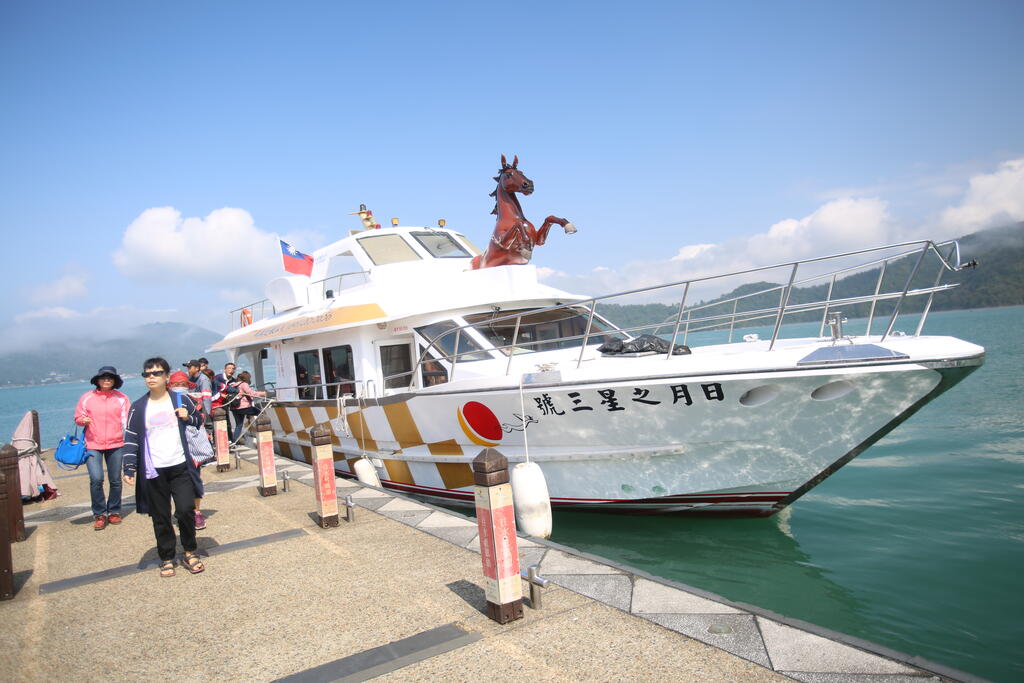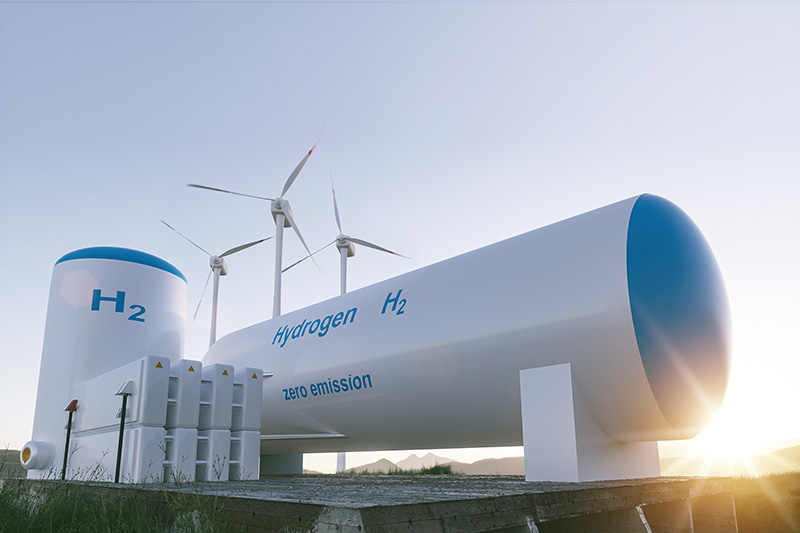Is Taiwan ready for the hydrogen economy?

Source:Shutterstock
The government has yet to include hydrogen in its renewable energy policies, but the private sector is already investing in this fast-growing area.
Views
Is Taiwan ready for the hydrogen economy?
By AmCham Taipei’s Taiwan Business TOPICSweb only
The Star of Hope ferry carries up to 90 passengers several times a day across Sun Moon Lake, a routine journey made exceptional by the boat’s drive system: electric motors powered by clean, emissions-free hydrogen fuel cells. Built by New Taipei City-based YC Synergies Ltd. and commissioned in 2015, the Star of Hope is the largest hydrogen fuel cell-powered ferry in Asia.
 (Source: Sun Moon Lake's website)
(Source: Sun Moon Lake's website)
YC Synergies is just one of dozens of companies manufacturing key components, specialized materials, and entire hydrogen fuel cell power systems for the burgeoning global fuel cell sector. Fuel cells use the chemical energy of hydrogen (or other fuels, including methane and methanol) to cleanly and efficiently produce electricity.
Fuel cells also operate at 60% efficiency, compared to around 25% for internal combustion engines. The electricity generated by fuel cells can be fed into the grid or used to power electric vehicles or machinery.
Global interest in hydrogen fuel cells has exploded in recent years, but Taiwan has been involved in the industry for decades. The Taiwan Fuel Cell Partnership (TFCP), a consortium of companies and research centers, was founded in 2001. Its dozens of members include the Industrial Technology Research Institute (ITRI) and the Institute of Nuclear Research (INER).
Taiwanese companies are suppliers of key components to U.S.-based Bloom Energy, one of the world’s largest manufacturers of solid oxide fuel cells (SOFC). The company’s systems use natural gas instead of hydrogen but still produce 60% fewer pollutants than typical fossil fuel generators. Taiwan also has several fuel cell systems integrators, some of which focus on hydrogen.
Others, such as the hiPower Green Technology Co. and Green Hydrotec Inc., use methanol as fuel. Although these are mostly small firms that sell only a few units annually, their systems are exported around the world.
Despite this global footprint, however, Taiwan has almost no domestic market for hydrogen fuel cells – or any fuel cells for that matter. Despite the high-profile success of its marine vessels, YC Synergies now focuses on China, where it produces hydrogen fuel cell systems for the booming heavy transportation market. The Chinese government provides huge incentives for hydrogen fuel cells and even includes hydrogen in its latest Five-Year Plan. China has already put around 10,000 hydrogen-powered trucks on the road.
Taiwan’s government, by contrast, offers little support for the hydrogen fuel cell industry, and while it does mention hydrogen energy and fuel cells in its Renewable Energy Development Act, there is no specific legislation aimed at fostering hydrogen energy.
“Energy policy is the most important thing for all renewable energies,” notes Meg Lin, an associate research fellow in the Green Energy and Innovation Technology division of the Taiwan Institute of Economic Research. Currently, “the Taiwan government only focuses on solar and wind power but needs to start preparing more energy storage demonstration projects ,” she says.
Lin, who also serves as TFCP’s CEO, says that the government does offer limited support for fuel cell development, given the large number of companies in Taiwan that have long been involved in that sector. Yet the prevailing attitude is that hydrogen fuel cells are too expensive, she says.

Leading economies, by contrast, are making a concerted push for the expansion of hydrogen energy in their jurisdictions. The EU, as part of its €750 billion Green New Deal relief effort and net-zero emissions goals, aims to produce up to ten million tons of “green hydrogen” – hydrogen produced from water via renewable energy-powered electrolysis technologies – by 2030, with total investments potentially reaching €470 billion (NT$15.8 trillion) by 2050.
Newly inaugurated U.S. President Joe Biden has likewise prioritized green hydrogen as part of his administration’s push to combat climate change, although he has yet to lay down specifics on how to promote it as an energy source.
Japan has long been a leader in hydrogen-powered transportation – the Toyota Mirai is the world’s only mass-produced hydrogen fuel cell vehicle (FCV) – and Japan expects to have 200,000 such vehicles on the road by 2025. South Korea, meanwhile, aims to introduce 6.2 million FCVs by 2040, along with 15 gigawatts of fuel cell power generation.

The Toyota Mirai, which is being sold in Japan, North America, and Europe, is currently the only mass-produced hydrogen fuel cell-powered vehicle on the market. Photo: Wikipedia
Law firm Frost and Sullivan has forecast that global hydrogen production will rise from 71 million tons in 2020 to 168 million tons by 2030, with revenues surging from US$177.3 billion to US$420 billion.
Taiwan’s suppliers of hydrogen fuel cell components in theory should be well-positioned to take advantage of this fast-growing market. As the global market expands and intensifies, however, the lack of a domestic base may put Taiwanese manufacturers at a disadvantage.
“Taiwan is too small to be the main focus for the industry, but we need to incubate the industry here, where the manufacturers can sharpen their skills. Then, when they reach out to the global market, they will be more competitive,” says Mark Huang, CEO of YC Synergies.
As the market surges, attracting more and more participants, competition will only get fiercer, says Huang. “The next three years will be critical for the local hydrogen fuel cell industry.”
Making Hydrogen “Green”
While hydrogen also shows promise as a low carbon energy source, the usual means of production, a cost-efficient process known as steam-methane reforming, is highly polluting and the end product is called “grey hydrogen.”
In order to reduce the carbon footprint of producing hydrogen and make it a more viable green energy option for consumers, companies both in Taiwan and globally have been working on more environmentally friendly solutions, such as electrolysis – generating hydrogen through water using equipment called electrolyzers – to produce “green hydrogen.”
Such a process, while preferable, can be prohibitively expensive. Given this, the vast majority of hydrogen produced in Taiwan and elsewhere is grey. (For more on grey and green hydrogen, see the accompanying article in this section).
Besides its high costs, green hydrogen production continues to present other, technical challenges. Hydrogen is highly reactive and so can degrade metal pipelines and storage tanks. It is also the lightest element and for transport must either be compressed or chilled to extreme temperatures to become liquified – processes that are energy-intensive.
Hydrogen is also highly combustible, and compression runs the risk of explosions. Liquefaction is a safer process, but it also requires huge investments in infrastructure and equipment and consumes lots of energy. The costs associated with both compression and liquefaction, combined with the high power demands of electrolysis, have made green hydrogen production less feasible.
A number of solutions are being tested and deployed to overcome these challenges. Japan, the leading proponent of hydrogen power, imports a petrochemical called toluene from Brunei, which it adds to its hydrogen supply. This mixture forms methylcyclohexane (C7H14), a toxic and flammable chemical that is nevertheless liquid at room temperature, removing the need for compression or liquefaction. The toluene is extracted and returned to Brunei for the next shipment.
Japan imports its hydrogen, as the local supply is insufficient to feed its hydrogen fuel cells. Taiwan, by contrast, uses hydrogen only for industrial processes, and as its current demand for hydrogen is met by locally based suppliers, it has no need for imports.
Veera Rajagopal, a graduate student at National Taiwan University of Science and Technology, leads a team that is using nanotechnology to store hydrogen in a solid state as a powder. The nanoparticles absorb the hydrogen, rendering it inert. When exposed to heat, the hydrogen is then released from the nanomaterials to become available as a gaseous fuel for a fuel cell. Rajagopal says the research is progressing but still doesn’t meet the standards for commercialization.
Meg Lin of TFCP says that transportation and storage costs and risks have impelled the local fuel cell industry to explore other fuels besides hydrogen. “Local people were afraid of large, compressed hydrogen storage facilities,” she explains. Instead, many manufacturers turned to methanol, a simple alcohol that can be produced from a variety of sources, as a fuel.
Obtaining hydrogen from methanol releases CO2, but much less than in methane steam reforming, and requires less energy than electrolysis. M.H. Rei, founder of Green Hydrotec, says that the overall carbon footprint of methanol-derived hydrogen can be even lower than electrolysis-generated hydrogen.
“So far, green hydrogen is still largely a dream,” he says. His company sells his methanol-hydrogen power generation systems throughout Southeast Asia and is looking to South Africa as a potential future market.
Taiwan supports numerous research efforts on hydrogen production. A research team at the Green Energy Development Center at Feng Chia University published a report in 2017 on the fermentation of hydrogen production from biomass. The report provides a roadmap to industrialization of this process, which it stated is nearing the market transition phase. A National Cheng Kung University research paper reports on the successful use of a photochemical process to produce hydrogen from organic sources.
Industry insiders also note that both ITRI and the state-owned Taiwan Power Co. (Taipower) are developing green hydrogen projects using renewable energy and electrolysis.
While these projects offer exciting possibilities, Mark Huang of YC Synergies says that Taiwan spends too much on basic research that is years away from commercialization at the expense of establishing demonstration projects and market subsidies for the industry that already exists.
“The government doesn’t need to be specific; the industry is very flexible,” he says, referring to the array of technological options and applications available in the hydrogen fuel cell space. “If the government can help the local players mitigate the risks, they will have an advantage in the global economy.”
But with China, the U.S., and Europe all entering the fray, “we must move fast,” he says.
This article, written by Timothy Ferry, first appeared in Taiwan Business TOPICS magazine, the monthly publication of the American Chamber of Commerce in Taipei. It is republished here with permission from the publisher.
Have you read?
♦ ‘Solar Power Fat Cats’: Green Energy Reduced to Money-making Game
♦ How renewable energy infrastructure could accelerate Asia’s green future
♦ How renewable energy infrastructure could accelerate Asia’s green future
Uploaded by Penny Chiang






